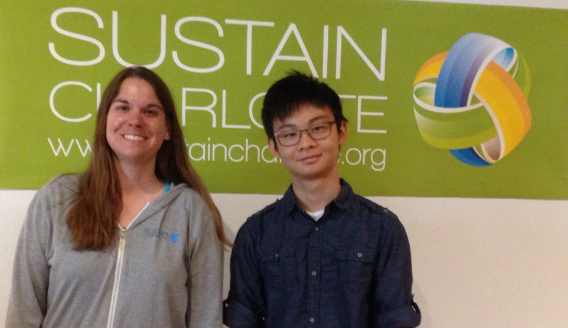Meet the Intern: Jamie identifies walkability challenges
Several talented high school and college students have partnered with us this summer as interns. We’re grateful for their hard work and the skills they bring to our team’s programmatic work and outreach efforts. Since sustainability is all about ensuring a high quality of life for future generations, we place a high priority on providing quality educational opportunities to our interns.
Today we’re sharing the story of Jamie Lee. Jamie helped to organize and lead several walkability audits for our Walk2Transit project this summer!

Our Program Director Meg Fencil (left) and intern Jamie Lee (right) worked together on Walk2Transit this summer!
Tell us a little bit about yourself.
My name is Jamie Lee, and I am a rising senior attending Providence High School here in Charlotte. I’m originally from Seattle, Washington and most recently moved here from Austin, Texas. I enjoy programming and music, interests that I plan to continue pursuing through college. But when I’m not debugging code or practicing etudes, I’m probably working on a jigsaw puzzle, playing tennis, or watching whatever’s on PBS (especially Sherlock and The Great British Baking Show!).
What were your main roles and responsibilities at Sustain Charlotte this summer?
This summer, I’ve been mainly working with Sustain Charlotte’s walkability audits — formatting maps and preparing questions into packets for tour guides, going on those audits to assess conditions on the way to bus stops, working with YouthQuake and the CMPD Envision Academy, and ultimately gathering the quantitative and qualitative data through photographs and the questionnaires.
How has this experience informed your understanding of sustainability?
Through this experience, I’ve become more aware of the difficulties of promoting sustainability in an environment that was founded on rather unsustainable practices. On those audits, I was able to see up close the trends of car dependency and urban sprawl in the Queen City, a city that has shown no signs of slowing down since the post-war, automotive prosperity of the 40s and 50s. However, this has only highlighted the efforts of advocates like Sustain Charlotte and highlighted the fact that ordinary members of the community can have an impact on an entire city.
What advice would you share with other students who want to make their community more sustainable?
No doubt, these “ordinary members” can include mere students like myself. Making a city sustainable isn’t just about pedestrian and transit-oriented development. We can make a place more vibrant by simply using what we love to do to color our surroundings. I miss the music of Austin’s Sixth Street and the wonders of Seattle’s Pike Place Market. From students to artists to chefs, anyone can make a community sustainable. Speaking out in a city of millions may seem a daunting task. But it only takes one voice for others to join in, discovering along the way that we are all pieces needed in the jigsaw puzzle of Charlotte’s future.
